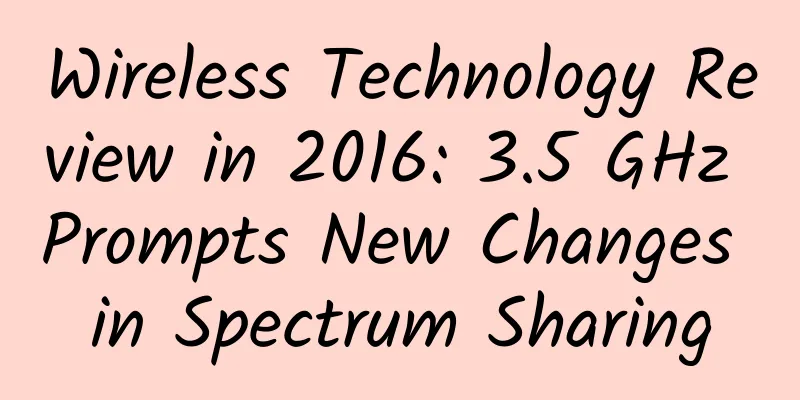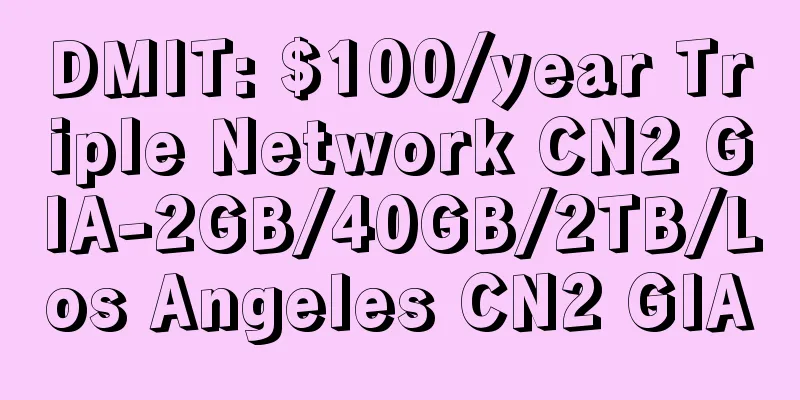Wireless Technology Review in 2016: 3.5 GHz Prompts New Changes in Spectrum Sharing

|
According to foreign media reports, in the past year, the wireless industry has discussed the issue of unlicensed spectrum (LTE-U) and its impact on Wi-Fi, predicted the final winner of the FirstNet contract, and analyzed the pros and cons of cellular-based Internet of Things (IoT) technology. As 2016 is coming to an end, the author will take you to review some of the hottest topics in the wireless technology industry this year.
5G testing and trials, and software-defined networking/network functions virtualization excellence The FCC announced its Spectrum Frontiers plan on July 14, boldly entering new spectrum areas and launching a large number of millimeter wave spectrum studies for 5G. Meanwhile, operators of all sizes have been conducting 5G tests and trials in 2016. Samsung Electronics announced multi-gigabit per second speeds at the 2016 Mobile World Congress, which were obtained by the company and Verizon in tests conducted at the US operator's headquarters in Basking Ridge, New Jersey, including live streaming 360-degree virtual reality content. AT&T has taken a less aggressive approach than Verizon, but it has also conducted multiple 5G tests, including one with Ericsson that reportedly achieved speeds of up to 14 Gbps. This summer, Sprint also conducted live millimeter wave system demonstrations over 73 GHz and 15 GHz in Santa Clara, California and Philadelphia. T-Mobile also conducted related tests, and the company's CEO Neville Ray called it a boring use case and slammed other operators. In addition, US Cellular and Ericsson conducted joint 5G tests in Madison, Wisconsin, with an overall peak speed of 9 Gbps and a speed of 1.5 Gbps at a distance of one mile. At the same time, AT&T and Verizon are also working to transform their networks from hardware-driven systems to software-defined networks and network function virtualization, aiming to improve revenue through cost efficiencies and more flexible architectures provided by software-driven systems. Sprint and T-Mobile have been less enthusiastic about announcing their plans, but it is expected that operators around the world will increasingly adopt software-defined networks and network function virtualization technologies in the process of developing 5G. Cellular and unlicensed IoT technologies enter the battlefield While Verizon continues to accelerate its IoT strategy so it can gain an edge over AT&T, the real battle isn’t between the two largest wireless carriers, but rather between the carriers and startups like Sigfox, Senet, and Ingenu (which offers unlicensed services). For much of 2016, these startups used IoT networks running on licensed and unlicensed spectrum to create a significant market-to-market advantage over companies like AT&T and Verizon, which continued to sell relatively expensive IoT services on their LTE networks. But the wireless carriers say that market launch advantage is gone. By the end of the year, carriers including AT&T were saying there was no need to wait: LTE Cat M is here now. Indeed, while Verizon didn’t reveal its target markets, it did say it was on track to deliver on its promise to commercialize Cat M1 by the end of this year, with nationwide expansion to follow in 2017. The emergence of the 3.5GHz CBRS band has led to new changes in spectrum sharing The FCC decided to do something innovative by creating the Citizens Broadband Radio Service (CBRS) in the 3.5 GHz band, which the commission designated as an “innovation band” in April of this year. The regulator freed up about 100 MHz of spectrum that had not been used for commercial purposes before, which, together with the existing commercial spectrum, formed a 150 MHz contiguous band. The CBRS Alliance was formed in August to advance LTE technology in the 3.5 GHz ecosystem; in December, the Wireless Innovation Forum (WinnForum) announced that it would make its signaling protocols and procedures related to the 3.5 GHz CBRS band available to the public - the first standard to address the Federal Communications Commission's new 3.5 GHz rules. Soon after, Federated Wireless and Alphabet's Access team reported an important milestone: demonstrating interoperability between their spectrum access systems, further verifying the sharing capabilities of the 3.5 GHz band. However, not everyone is completely on board with the 3.5 GHz band, including the two Republican commissioners who are expected to stay on after Trump takes office in January 2017. Even if those two commissioners, Ajit Pai and Michael O'Rielly, ultimately vote in favor of the plan, questions remain. The commissioners called 3.5 GHz an experiment and pointed out areas of disagreement, including what O'Rielly called the short-term licensing terms for the Priority Access License (PAL) — which wireless carriers have asked for an extension. It remains to be seen whether the FCC will revisit these topics under the new administration. LTE-U/LAA threatens Wi-Fi, and Wi-Fi fights back After months of debate over the use of unlicensed spectrum to launch LTE services, the Wi-Fi Alliance released its much-anticipated Wi-Fi/LTE-U coexistence test plan in September. LTE-U supporters, including Verizon, T-Mobile US and Qualcomm, insist that they will coexist harmoniously with Wi-Fi, but cable and Wi-Fi leaders disagree, fearing that LTE will crowd out Wi-Fi. The Wi-Fi Alliance said the test plan was the result of compromises between all parties, so no one will be satisfied with all of this. In fact, the test plan in November once again raised industry concerns: Nokia expressed serious concerns about its ability to complete LTE-U device testing and complained that the test plan submitted to the committee was not a complete document. But the Wi-Fi Alliance countered that Nokia had raised the above issues before the discussions between the parties were completed. So it's clear that the debate between the pro-LTE and pro-Wi-Fi groups over unlicensed spectrum will continue into the new year. AT&T expected to become partner of Rapid Response Network Authority After years of work, the Rapid Response Network Authority finally issued a request for proposals (RFP) in January 2016 to deploy a national broadband network dedicated to public safety. In April, the agency extended the deadline for bidders to submit proposals to May 31. In December, AT&T was expected to emerge as the winner after two other bidders, Rivada Mercury and pvdWireless, announced that they had received notice of elimination. Although some analysts believe that Verizon is the ultimate winner, the operators have mostly remained silent on the situation. Although the Rapid Response Network Authority has not yet officially announced the winner, Rivada Mercury has protested the situation, saying that the Department of the Interior's assessment was too arbitrary and capricious. If the relevant legal issues are resolved, the authority is expected to sign the contract next spring. If AT&T wins, it will become an important business for the company - AT&T will be able to use 20 megahertz of 700 MHz prime spectrum and sell additional network capacity that public safety will not use. Analysts believe that no matter who wins the contract in the end, the Rapid Response Network Authority will pay more attention to the telecommunications tower department because the deployment of this network requires the construction of a large number of new base stations. The FirstNet Agency said it will continue to advance its goal of building a public safety wireless network. The agency made a significant move in November when it launched the FirstNet Innovation and Test Lab at its technical headquarters in Boulder, Colo. The lab will serve as a "plug and play" environment where the FirstNet Agency and its future private industry partners will test public safety features, devices and applications before deploying the nationwide network. |
>>: 5G is coming: analyzing the fronthaul solution of high-density wireless systems
Recommend
High growth in network equipment in Q3 drove an 8.1% increase in cloud IT revenue
Currently, the pace of cloud data center construc...
spinservers: $99/month-E3-1285v5/32GB/1TB NVMe/10Gbps/San Jose data center
Last week we shared the news that spinservers is ...
VirMach: $1.15/month KVM-512MB/15GB/1TB/multiple data centers available
VirMach released several special packages on Blac...
Kunpeng University Tour is coming soon. How can the Sichuan-Chongqing Twin Cities Economic Circle be without Kunpeng?
[51CTO.com original article] At 2:00 pm on Thursd...
Cutover failed, resulting in 3/4/5G network communication failure
[[429420]] A cutover and replacement by Japanese ...
Gigsgigscloud Japan CN2 limited package (TYO-V-SE-01) from $22/month, three-network CN2 return
Gigsgigscloud launched a Japanese data center clo...
All in one article: 20 industries that 5G can change
The 5G era is coming. What new changes will it br...
Tencent interview: On a 32-bit 4GB system, accessing 2GB of data, what will happen to the virtual memory?
Hello everyone, I am Xiaolin. Today a reader sent...
ZJI: 600 yuan/month-E5-2637v2/16GB/1TB SSD/20M CN2/Hong Kong Kwai Wan Data Center
Last month, ZJI offered a monthly discount for Ho...
Top 7 web scraping tools for 2019
The Internet is constantly flooded with new infor...
Energy-saving building 5G solutions are the key to green buildings
Building equipment suppliers are prioritizing gre...
No more worrying about data loss: use rsync to build your automated backup solution
In modern IT environments, data backup is a vital...
How long will it take for 5G small base stations to "take off"?
In the era of rapid changes in information and co...
TNAHosting: $5/month-4 cores/12GB/500GB/15TB/Chicago data center
TNAHosting is a foreign hosting company founded i...
A complete guide to worry-free WiFi coverage during the Dragon Boat Festival holiday
The Dragon Boat Festival holiday has begun. Durin...









